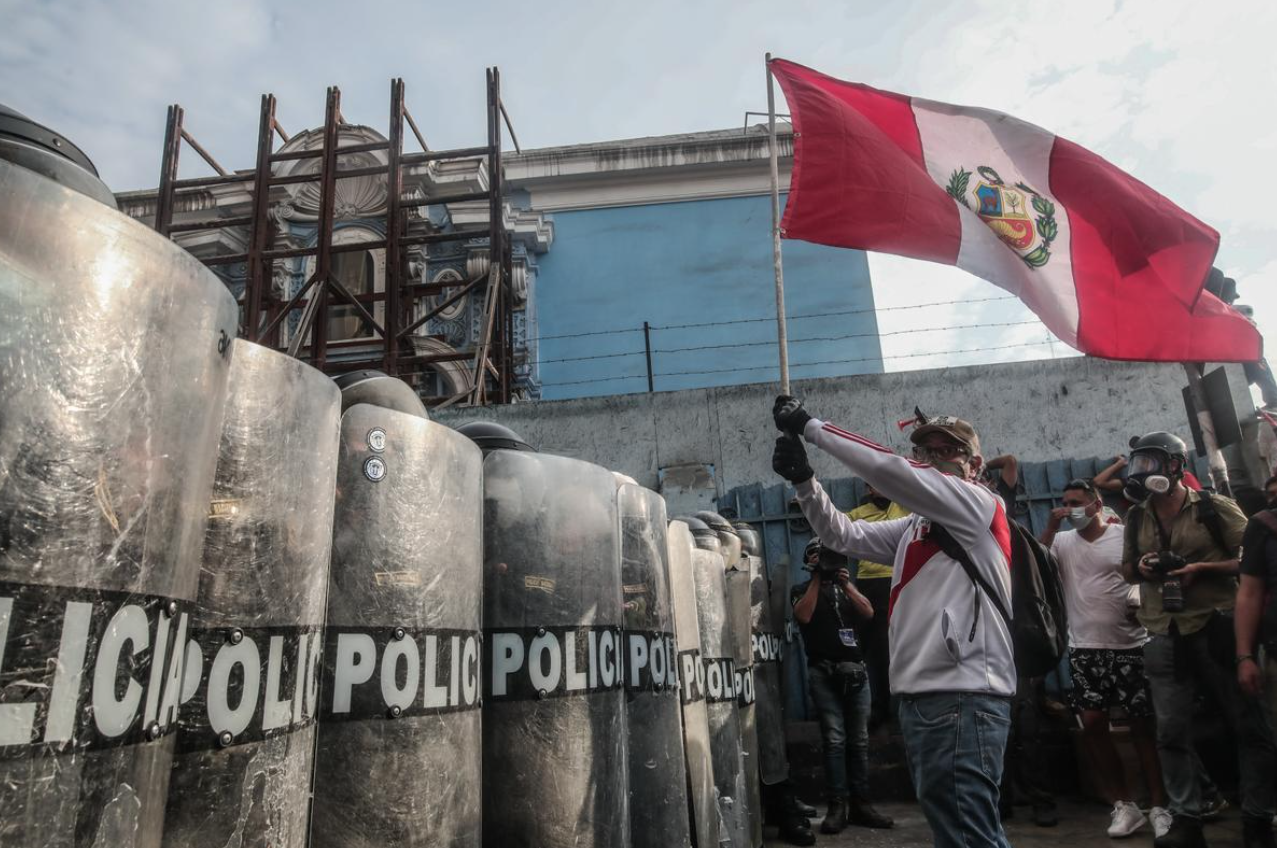Sixty dead in forty-seven days. Peru is redrawn as an indelible caricature of our collective incapacity, fears, and incompetence in the search for a lasting common good. Like that country in the children’s movie Peter Pan, Peru is the geographical never-never-land, a redoubt in which Comanches, pirates, and perennially immature adults coexist, but without accountability or respect for the law. As a result, we have a potpourri of interest groups with the main objective of forcing the resignation of President Dina Boluarte and the immediate call for elections.
Now, the question style Vargas Llosa that I paraphrase below without wanting to force the cliché is the following: what was the moment Peru got screwed this time?
To suppose that this gale of violence and anarchy arose spontaneously on December 7th, 2022 is supremely naive for anyone who claims to be Peruvian. If we look for a recent origin, Peruvians began to weaken the fragile political tradition that started in 2001 with the misuse of legal and constitutional tools but of exceptional use, such as motions of censure, motions of vacancy, and constitutional closures of Congress.
Since 2016 we have witnessed fatigue among all political actors: fujimorists, leftists, followers of Martin Vizcarra, and those from the right wing in general, and also all organized crime in the country: drug traffickers, land traffickers, regional chieftains linked to illicit activities such as mining and illegal logging, and many more, who, in turn, get richer and gain power in this misrule and chaos. Where the law does not rule, the power of their money rules.
The political class, if it can be called that in Peru, used legal and constitutional mechanisms in an irresponsible manner as if weapons were given to a child from Neverland who does not distinguish the severity of the use as a last resort of each one of them. Today the left claims indignantly for the departure of Pedro Castillo from the Presidency but forgets that in March 2018 it was the most enthusiastic, together with Fujimorism, in giving rise to the resignation of Pedro Pablo Kuczynski and the rise of Vizcarra. In good Christianity, the cow forgets when it was a calf.
As a result, before our eyes passed de facto dissolution of the Congress and presidential vacancies contributed to the fact that, since then, we have had six presidents: on average, one per year.
Such fragmentation led to the uncertainty and volatility of the 2021 elections which, due to their unpredictability, led to two candidates who, together, accumulated slightly more than 30% of the valid votes in the first round. Never, since the end of the dictatorship of the Armed Forces in 1980, have two presidential candidates gone to the second round with less than 50% obtained by both political forces.
The elections were not exempt from questioning, which would have come from either side had they been losers. The questioning of the electoral system and rules is a symptom of the precariousness and institutional weakening that have been dragging on since some unwritten rules that allowed a certain balance of government every five years from 2001 to 2016 were broken.
Precariousness and improvisation cannot give birth to order and predictability. Which is why Castillo’s rise to power came bathed in empty gestures, without the slightest idea of how to govern and with hundreds of favors to fulfill for several of the interest groups that coexist on the margins of legality in Peru. Some with open processes for terrorism, links with drug trafficking, accusations of domestic violence, and charlatans practicing medicine in the Peruvian periphery, among others, became the highest executive positions at the national level: the least appropriate to lead the destinies and illusions of a more prosperous life for millions of Peruvians.
The incompetence and malice of several of these officials led to the implosion of public entities that, after decades of clientelism and politicized use, had become executive arms of politics and management. Peru became administered by individuals who hid bundles of dollars in a bathroom of the Government Palace, or who embezzled public money to, unusually, pay debts in the financial system. Peru was seen as a small-time spoil for those who had taken it by the force of ignorance, immaturity, and the fragmentation of its people.
As a corollary of this disaster, the accusations against Castillo became so many and so true that his vacancy seemed to be a fact. Several unproductive vacancy motions were carried out since 2016, but perhaps the most forceful and necessary was the one that was being prepared at the beginning of December 2022.
In despair and anguish, barely advised by the wayward former Prime Minister Aníbal Torres and by his upstart chief of staff, Betssy Chávez, he called for the most absurd coup d’état ever seen in the History of Peru and, undoubtedly, in universal History. Totally deprived of the power of the Armed Forces, any attempt at democratic interruption is unfeasible. However, he took such a decision, but with full knowledge of what he was doing and of his objective: to avoid prison and rule de facto.
Fortunately for the country, Castillo’s evident incompetence to govern was also evident in the Kafkaesque coup d’état he attempted to perpetrate. Immediately, the Congress, also incompetent to put together a solid vacancy motion for months, was finally able to hold a session and, with abstentions from its own supporters such as Guido Bellido, approved the removal of the president. In just three hours, Peru went from being the victim of the first coup d’état of the 21st century to have the ex-president imprisoned and taken to the nearest police headquarters.
Is Dina Boluarte a constitutional president? Yes, she is. Pedro Castillo was removed from office for violating the Constitution he swore to defend. If there is a coup leader, it is Castillo, not Boluarte. However, not even twenty-four hours passed for all those interest groups, who lost the favor they obtained during Castillo’s corrupt regime, to take to the streets, in order to whip up and provoke thousands of Peruvians with the purpose of freeing him, forcing Boluarte’s resignation and calling for a Constituent Assembly that still does not generate consensus.
Now, Boluarte’s administration has been in trouble from the beginning: she has no loyalties in Congress or political party. She has built a government with what she could, and in this improvisation, it is not surprising that the brutality and the ineffective management of intelligence actions have led to such a clumsy containment of these interest groups. The sixty deaths are a tragedy, because, at the end of the day, those who are killed are not the whipping boys on one side or the generals on the other: they are the poor people who, as cannon fodder, go to contain the marches or throw themselves against a police platoon. Of course, what happened requires a thorough investigation and the punishment of those responsible for these deaths. Following that line, it is also essential that the origin of these actions of both the whipping boys and agitators as well as those who carry out executive orders be clarified.
This should lead us to not one, but several reflections.
In a country like Peru, where laws, rules, and documents exist ad nauseam, the problem is not in changing the text, but in enforcing it. Peru’s problem does not depend on the magical thinking of writing another Constitution. The current Magna Carta protects and promotes, among other matters, the right to public and quality health and education. If it is not enforced, it is not because of the text, but because of the incompetence and immaturity of the national ruling class that does not know how to face this demand, and with the reinforcement of criminals and groups outside the law that thrive on this anarchy without a social contract.
Peru urgently needs to rebuild a social contract of respect for life, for the physical and mental integrity of people, for decent work, for access to health and quality education, a decent retirement, order, security, private property, and for the opportunity to seek a better future for themselves and their families. Peru is unviable without these conditions and the predictability to plan for a better life.
Thus, it is regrettable that the foreign media only buys one version of the facts, when what is happening in the country is the incendiary result of organized sectors that only seek to regain quotas of power. The complexity of the context does not allow for dichotomous visions of black and white, good and bad. However, it seems that the international press has bought into this story.
It is true, in Peru there are urgent postponed demands, but these do not arise on December 7th, 2022, and it is extremely naive to assume that they will be met after all this tragedy. Those voices, real and legitimate, will be drowned out by the self-interested claim that is reduced to the exit of Boluarte and the change of the Constitution. It is even more tragic that this is the way it is seen and allowed to pass with indifference.
Those who anticipate with a crystal ball what may happen in the future do not deserve the least attention, since in Peru, such an exercise is mere mysticism. After the national strike of January 19th, it is as likely that Boluarte will resign as it is that the violence will continue. In the meantime, the usual immature people, the Comanches, and the pirates continue to make Peru that country where no one governs, the never-never land.
*Translated from Spanish by Janaína Ruviaro da Silva












